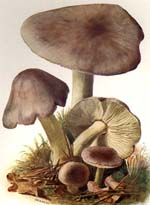Clitocybe cyathiformis
 Key to Gilled Mushrooms Key
Key to Gilled Mushrooms KeyThis is a key to gilled mushrooms, that is, mushrooms having a definite cap with a fertile surface consisting of gills. The fruiting body usually also has a stem, although that may be lateral or absent (usually, then, the mushroom is growing from wood). You can use this key to identify mushrooms that you find.
 Agaricales Order
Agaricales OrderFruiting body containing fibers (usually in the stalk)
 White Spored Suborder
White Spored SuborderSpore print "light-colored": white or buff, sometimes tinged with pink or tan. Greenish and (except for the Russulales) yellow spore prints also go here
Stalk fibrous, not fracturing like a piece of chalk
 Tricholomataceae Family
Tricholomataceae FamilyNone of the special features distinguishing the other white-spored genera:
Gills not free, as in the Lepiotas and Amanitas
Basidia not extra-long, as in the Hygrophoraceae
Spores smooth, except for Lentinellus
 Terrestrial Trich Subfamily
Terrestrial Trich SubfamilyGrowing on the ground
 Woodland Normal Trich Tribe
Woodland Normal Trich TribeFound in woods
Not rooting
 Clitocybe-like Fungi Subtribe
Clitocybe-like Fungi SubtribeGills attached to decurrent
Coloration usually white to greyish brown, sometimes purple or with purple tones
Never with a ring of any kind
 Clitocybe Genus
Clitocybe GenusGills attached to decurrent, crowded
Cap glabrous, small to very large; often aging into a funnel shape
Spore print often tinged with pink or buff
Look for things here if they have non-free gills and don't fit the other taxa
 Other Clitocybes Section
Other Clitocybes SectionStalk equal
Fruiting body not all white, or with purple colors
Clitocybe cyathiformis (Fries) Kummer
Here are the characters that distinguish this species from the others in its group. For its more general characters, see higher up on the page.
If there's just a few words or a microscopic feature here, a more thorough description can be found above.

Diagnosis
- Cap up to 3" across; funnel-shaped in maturity; dark brown, stalk concolorous
-
Gills light brown or greyish brown to brown
-
In humus and on rotting logs, in woods and at their edges
Microscropic Characters
Comments
As with so many species, I have contradictory info on the color change in the gills: one book says they start light and darken, the other has it the opposite way






 Key to Gilled Mushrooms Key
Key to Gilled Mushrooms Key Agaricales Order
Agaricales Order White Spored Suborder
White Spored Suborder Tricholomataceae Family
Tricholomataceae Family Terrestrial Trich Subfamily
Terrestrial Trich Subfamily Woodland Normal Trich Tribe
Woodland Normal Trich Tribe Clitocybe-like Fungi Subtribe
Clitocybe-like Fungi Subtribe Clitocybe Genus
Clitocybe Genus Other Clitocybes Section
Other Clitocybes Section





